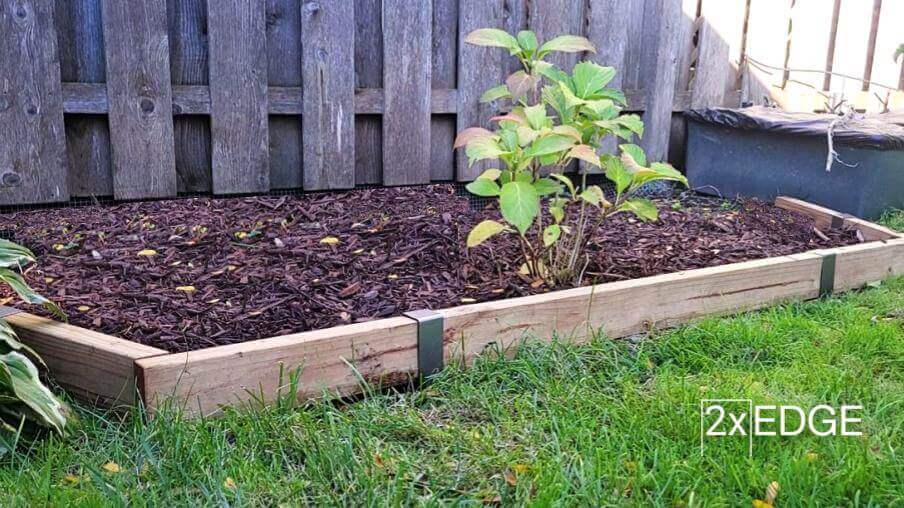About This Tutorial
Want to make functional and attractive mulch beds that are fast and easy to DIY?
Here's a way to do just that! The only digging you’ll do is to put in your plants!
In this step-by-step guide we use 2xEDGE, the two-by lumber landscape staple, to install the wood edging that will serve as the container for your brand-new garden bed.
2xEDGE is a great time saver when creating garden beds.
No digging or drilling is required to install edging around your flower bed, tree surround, vegetable garden - anywhere you need to create a mulch bed.
Early Spring is around the corner! Get a jump on the growing season with this quick and effective approach to making mulch beds.
Tools and Materials
Tools
Required
- 16-ounce rubber mallet
Optional
- Garden hose
- Garden rake
- Lawn mower
- Power or hand saw
- Shovel
- Speed square
- Tape measure
- Trowel
- Wheelbarrow
Suggested
- Gloves
- Safety goggles
Materials
Required
- 2xEDGE lumber landscape staples.
- Lumber - Our example projects use 2x4* pressure treated lumber.
- Mulch - Wood chips, bark mulch, grass clippings, leaf mulch, pine needles - there's a lot of mulch to choose from. If you're unsure about what mulch material to use, here's a post with the pros and cons of commonly used organic wood mulch. And here's a cost comparison of bulk mulch vs bags of mulch that includes info about free wood chips.
Optional
- Soil - Can be store bought garden soil, top soil by the cubic yard from your local landscape supply company, organic compost from your compost pile - up to you.
- Weed barrier - You can lay landscape fabric, sheets of newspaper, black plastic sheeting to control weeds. All you need is a thin layer to keep weeds at bay.
Step-By-Step Instructions
1. Determine the location and shape of your bed
In this first step, think about the conditions of your installation area. Will your mulch bed be in a sunny or shady spot? Dry or wet? Knowing the area will help you figure out what type of mulch would work best.
For example, if your bed will be situated on a slope, avoid using bark nuggets for your mulch. Nuggets float and could float away in a downpour.
Are you making a tree surround? Creating a simple four-sided flower bed? Knowing the shape of the bed will help you assess how much edging, soil, and mulch you'll need.
2. Mow the area (optional)
If you're installing your new mulch bed in a grassy and/or weedy area, you might want to give the space a quick mow. This will help later when you're laying down your weed barrier.
It's a good idea to mow before moving on with next steps so that you don't compact your grass by walking on it while you work. Grass is easier to mow when it's not mashed down.
You don't need to dig up the grass where you're installing this bed! This approach to making a mulch bed is easy and fast. Hard work isn't required!
3. Measure
Measuring the installation area will help you:
- figure out how many square feet your new bed will occupy so that you can determine how much organic matter - soil, mulch - you need;
- assess how many linear feet of lumber you'll need to edge around your mulch bed.
Square footage
Here's a calculator to help you determine how much mulch or soil you'll need. Provides measurements in cubic feet and number of bags.
Linear feet of lumber
There's an easy way to figure out how much lumber you'll need when you use 2xEDGE lumber landscape staples.
2xEDGE works with “two-by” (two inch thick) dimensional lumber that is readily available at big box stores like Home Depot, local hardware stores, and lumber yards.
Dimensional lumber comes in pre-cut lengths. Common lengths available to purchase: 4-foot, 6-foot, 8-foot, 10-foot, 12-foot, 16-foot, and 20-foot.
Buying pre-cut lumber let's you skip a step: cutting your edging lumber down to size.
An example: this raised bed was made with 4-foot and 8-foot pre-cut 2x4s.
This was made with pre-cut lumber and we used simple butt joints at each corner. This means there was no need to cut the lumber to size or cut the ends of the lumber at an angle.
A project done with pre-cut lumber and 2xEDGE can come together really quickly without a lot of work. Curious? Check out project plans.
4. Cut edging lumber to size
If your mulch bed requires custom lumber lengths, now is the time to make your cuts.
2xEDGE works with any length of two-by lumber. Check out this guide to learn how many 2xEDGEs you'll need to staple your lumber securely.
At first glance, you might think using two-by lumber would confine you to mulch beds that are square or rectangular. With a little imagination and a few angle cuts, you can do a lot with two by lumber.
An example: this six-sided hexagon shaped raised tree surround was made with six 4-foot 2x4s.
To make this project we cut each end of the lumber at a 30-degree angle. This is a pretty straightforward thing to accomplish with power tools like a miter saw (aka chop saw) or circular saw. You could also use a hand saw which would add a beneficial cardio work out.
Make your own hex-shaped mulch bed. Check out the plan.
5. Install your edging
This next step is the fun part: using your 2xEDGE staples to install your lumber!
All that this step requires is arranging your lumber on the ground and tapping your 2xEDGE staples into place with your rubber mallet. A 16-ounce mallet works perfectly.
6. Dig holes for plants (optional)
If you're ready to plant right away, dig holes for your plants now.
You won't put them in yet so keep track of each hole so you can find them later.
If you're just making a mulch bed for now, skip this step.
7. Install a weed barrier (optional)
Please note: We used to use cardboard as a weed barrier but learned that this is not a good idea. Check out "Easy & All Wrong! The DIY Cardboard Method In the Garden" for details including an expert recommendation to use a thick layer of wood chips only - no weed barrier - in these types of projects.

If your installation area is covered in grass and/or weeds, you'll want to use a weed barrier to suppress weed growth and keep weed seeds from sprouting.
I like to use organic material rather than weed killer or a pre-emergent herbicide for this step.
We use cardboard which adds carbon as it breaks down. It's a great way to increase soil quality. Your plants - and plant roots! - will thank you.
If you use cardboard, simple brown cardboard boxes with minimal to no printing on them work great.
Avoid glossy or coated cardboard; it won't break down and can introduce stuff you don't want in your plant bed.
If you dug holes for plants in the last step, lay the cardboard around your planting holes.
Grab your garden hose and give your cardboard a good soaking.
8. Add soil (optional)

If your installation area has good soil that's ready for planting, you can skip this step.
Otherwise, add an inch or two of soil to the entire bed and smooth it out.
If you have plants ready to go, plant them now.
9. Top it off with mulch

Put a good layer of mulch over the top of your bed and level it out.
Voila! Your DIY mulch bed is complete!
* A two-by-four piece of lumber should be 2-inches thick and 4-inches wide, right? Well..., no. The actual dimensions are 1.5-inches thick and 3.5-inches wide.




